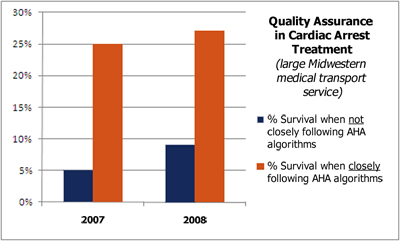Cardiac arrest patients stand to benefit from being treated with ArrestPACs, as improved survival rates may accompany the consistent following of ACLS treatment protocols (notably the American Heart Association algorithms).
Further, paramedics benefit from a tool that helps them more consistently follow ACLS treatment protocols — no matter how long ago they may have been trained, or when they may have last treated a cardiac arrest patient.
Cardiac Arrest
Sudden cardiac arrest kills more than 325,000 people each year in the United States - more than the total death rate for breast cancer, lung cancer, and HIV/AIDS combined.
Advance life support for cardiac arrests on the scene includes immediate cardiopulmonary resuscitation, ventilation, and the administration of antiarrhythmics and/or vasopressors until a return of spontaneous circulation.
American Heart Association Standards
Since 1974, the American Heart Association has published evolving standards for providing basic and advanced life support, including specific advanced cardiovascular life support (ACLS) procedures for the resuscitation of patients suffering from cardiac arrest.
These ACLS procedures - grouped into flowcharts and called “algorithms” - are the industry standard for both pre-hospital and in-hospital emergency treatment of cardiac arrest.
Patient Data
The ArrestPAC inventors are two emergency medicine physicians who serve as medical directors for a large medical transportation service in the upper Midwest. Together, they oversee the care of more than 300 cardiac arrests every year.
Through their quality-assurance process, these two medical directors observed that despite ACLS training twice each year for paramedic teams, EMS providers were not closely following American Heart Association algorithms during the stress of cardiac arrest calls.
Common variances included introducing an advanced airway too early, administering drugs out of order, or delaying IV access.
However, when EMS teams did closely follow American Heart Association algorithms in their treatment of cardiac arrest, patients had markedly greater survival rates:

Bolstered by data showing improved patient survivability when EMS providers closely follow American Heart Association algorithms, the doctors sought a way to help better execute ACLS training in the field.
Specifically to:
A. Ensure each cardiac arrest patient received the best possible care, emphasizing the established standards promoted by the American Heart Association; and,
B. Help emergency response teams better follow American Heart Association algorithms in their treatment of cardiac arrest — acknowledging that cardiac arrest can be a very stressful event to treat.
ArrestPAC
The doctors’ solution was to create ArrestPAC: A cardiac arrest treatment bag that provides direction, organization, and efficiency to one of the most stressful events in emergency medicine!
ArrestPAC is designed to quickly guide paramedics through the American Heart Association algorithms for cardiac arrest treatment, both in presentation and content.
For example, the ArrestPAC unfolds in a way that presents the correct treatments in the correct order for EMS providers to follow American Heart Association algorithms simply by opening and deploying its contents.
Each ArrestPAC includes quick-reference cards reminding EMS providers of individual responsibilities and workflows in the treatment of patients displaying V-FIB, V-TACH, PEA, or Asystole.
ArrestPAC’s patent-pending design defaults to the American Heart Association algorithms for treatment, but allows variation to accommodate the wishes of individual medical directors in modifying treatment protocols. ArrestPACs are thus flexible tools for promoting ACLS standards, even when local standards vary from American Heart Association algorithms.











